In August of 1970, 80 killer whales from L-25 pod were encircled by a net at Penn Cove in Puget Sound, Washington.
Herded together by a sophisticated operation involving speed boats, planes and explosives, the young whales were then lassoed and literally dragged out of the water and away from their families.
All told, seven killer whales, also known as orcas, were captured in the Penn Cove operation and five died, according to the Whale and Dolphin Conservation.
In an effort to limit bad press – and because dead animals counted towards the team’s capture quota – the deceased animals were subsequently hidden at the bottom of the ocean.
“They had us cut the animals that were already dead open and put rocks inside their cavity and anchors around their tails and sink them,” recounts John Crowe, a participant in the hunt, in the documentary film The Killer Whale People. “It was because of publicity and the money.”
Unfortunately for the whale hunters, three of the cetacean carcasses would eventually float to the surface and wash up on Whidbey Island.
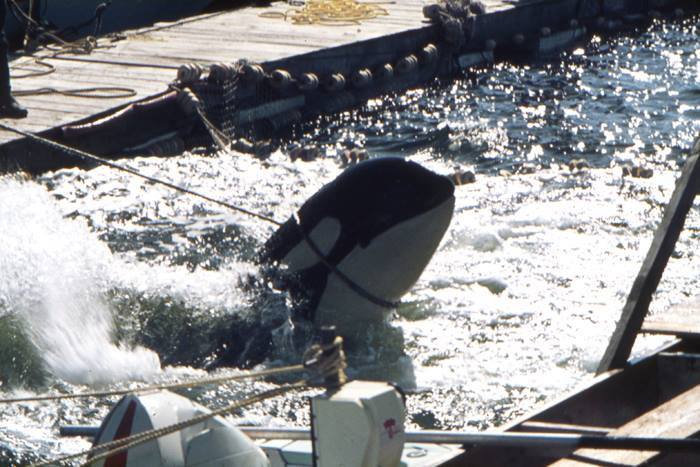
The incident remains one of the most infamous in the decades-old history of North America’s live killer whale captures and was a turning point that contributed to the Marine Mammal Protection Act of 1972 in the US, which marked the beginning of the end of live cetacean captures in America.
While to many in the West, the idea of rounding up whales, plucking them from their aquatic home and sentencing them to lifelong incarceration may seem archaic (particularly in the wake of the 2013 documentary film Blackfish), public opinion on the other side of the Pacific, here in China, is much more open towards to the subject.
As of June 2016, there were at least 39 ocean theme parks spread across the People’s Republic, with 14 under construction. The majority of these attractions are located on the country’s populous eastern coast.
According to numbers provided by the China Cetacean Alliance (CCA), these facilities house an estimated 491 cetaceans representing 11 species, of which belugas and bottlenose dolphins are the most common.
Guangdong province is home to the most aquatic facilities in the country, boasting five parks and 122 captive cetaceans.
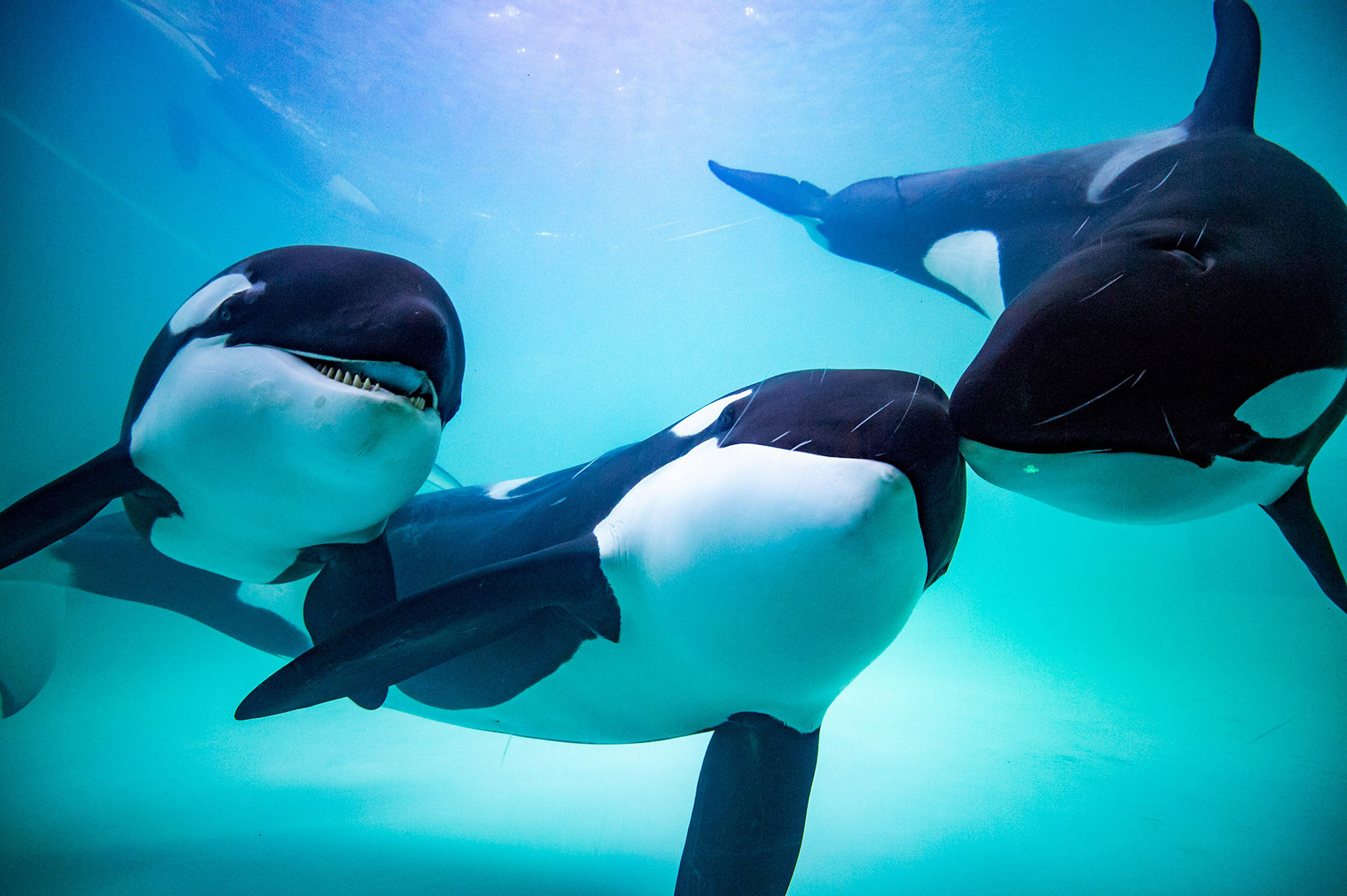
There are currently believed to be 15 orcas held in captivity in China, nine at Chimelong Ocean Kingdom in Zhuhai, four at Shanghai Haichang Polar Ocean World and two at Linyi Polar Ocean Park.
Unlike their North American counterparts, marine parks in China have yet to master the ability to breed cetaceans in captivity, something that has allowed parks like SeaWorld to avoid the controversial undertaking of capturing live whales repeatedly over several decades.
Of the 39 marine entertainment facilities located in China, only six claim to have bred cetaceans in captivity, although, according to the CCA, in at least two of these cases the calves are known to have died.
But without established breeding programs, how do Chinese marine parks feed their increasing demand for animals?
It turns out the answer is as dark and troubling as the infamous Penn Cove cull.
The Last Legal Hunting Ground
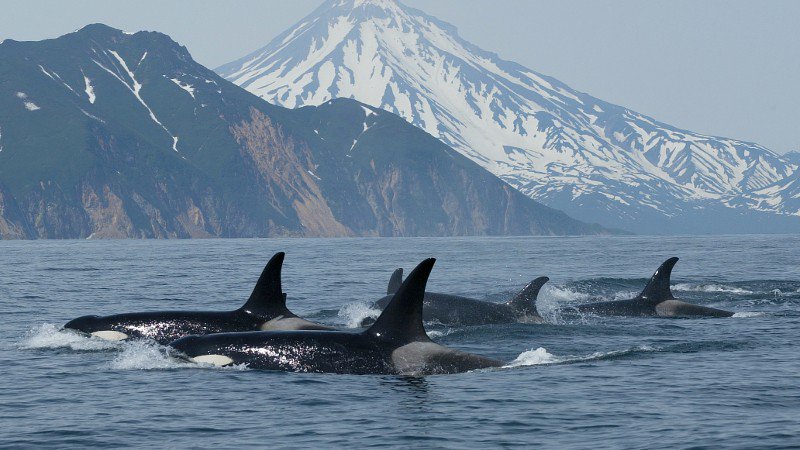
To tell the story of China’s captive killer whales, we must venture beyond the borders of the Middle Kingdom to Russia’s far eastern Okhotsk Sea.
With the practice of hunting wild orcas now banned in Canada, the United States and Europe, the Okhotsk Sea is one of the last areas where it’s still legal to capture killer whales.
American environmental journalist Todd Woody explored the Russian killer whale hunting operations in a 2016 article for takepart.com titled 'China's Marine Park Boom Is Driving the Capture of Whales and Dolphins.' In the story, he speaks with orca hunter turned anti-captivity advocate Jeff Foster about a 2011 phone call from a European animal broker looking to recruit him to capture eight orcas off Russia’s Pacific coast.
In addition to helping orchestrate the whales’ capture, the job would also include basic training of the wild animals. The payout? A whopping USD7 million.
“The Chinese were the buyers, and the Russians had the permits. They wanted to bring me in to do the capture and transport and initial training of the animals,” Foster is quoted as stating in the article. “The Russians had been trying to capture killer whales for 15 years, and they just didn’t have qualified people showing them how to do it.”
“There are no Chinese boats [involved in cetacean hunts], they are actively buying these animals from Russia or Japan.”
Despite the fact that the identity of the Chinese buyers was never revealed to Foster from the animal broker, we can be confident they had money to burn. On top of the USD7 million offered to Foster, Woody’s story suggests the buyers would have had to fork over somewhere between USD25-80 million for the orcas in addition to the cost of shipping the giant cetaceans thousands of miles.
Foster ultimately turned down the USD7 million payout, but it didn’t matter: the hunt would go on regardless. In October of 2013, seven killer whales were pulled from the the Sea of Okhotsk, followed by at least five more animals in 2014 and 2015.
Although the main buyers of Russia’s whales appear to be people living or doing business in China, there is no evidence that Chinese boats or hunters are actively involved in catching the orcas that end up in the country.
According to Woody, the culling of killer whales in the Sea of Okhotsk is “strictly a Russian operation.”
Environmental activist and Sea Shepard Conservation Society Founder Paul Watson affirms this view. “There are no Chinese boats [involved in cetacean hunts], they are actively buying these animals from Russia or Japan.”
According to Watson, China gets only 20 percent of their cetaceans from Russia, and the other 80 percent come from Japan.
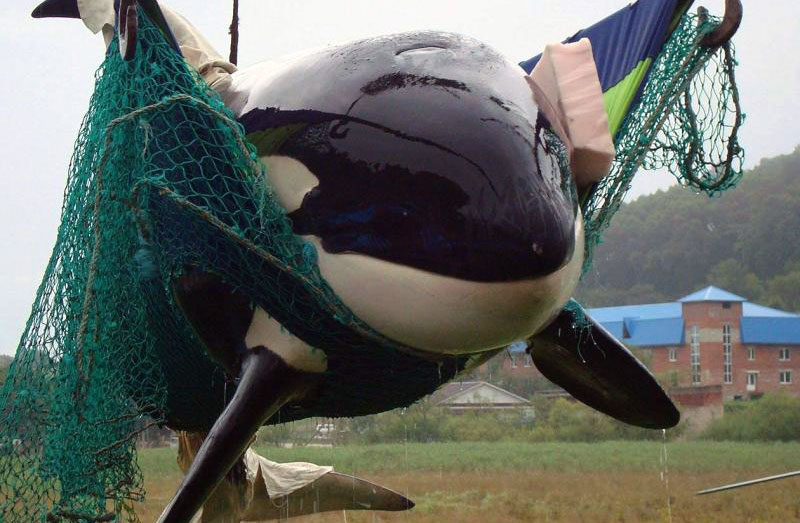
Once captured, the whales are transported more than 900 kilometers by truck to small holding cages in the Russian port city of Nakhodka. From there, their journey to an aquarium may be undertaken again by truck or plane.
“They go a long way from the capture area to where they are held, and then they are held in these small pools and transported to China,” Woody told That’s. “It costs a lot of money to fly a killer whale and it’s much easier if you want to avoid attention from anti-captivity groups to use a truck.”
Florida-based marine mammal consultant Mitchel Kalmanson is quoted by Woody as stating the journey to China by truck takes between seven and 10 days, something he knows from experience. According to 'China's Marine Park Boom Is Driving the Capture of Whales and Dolphins,' Kalmanson was hired back in 2014 by a London insurance company to oversee the prep work for the transport of orcas from Russia to China.
As one would expect, transporting an orca by truck for such a long period of time poses a number of risks to the animal. Firstly, cetaceans live their entire lives in water, which delivers uniform support through even distribution of pressure over the animal’s body. This, according to the CRC Handbook of Marine Mammal Medicine, results in a “functional weightlessness” that allows the mammal virtually effortless breathing. Take a cetacean out of the water and problems with respiration will follow.
To combat this, modern orca transport utilizes giant fabric slings suspended in water-filled transport boxes – something that allegedly mimics the weightlessness the animals experience while fully submerged in water.
“He [Kalmanson] wouldn’t be surprised if animals died in transport.”
Despite the use of slings and water in transport units, it’s difficult to deny that putting an orca in a box and then driving for a week cannot be a pleasant experience for the mammal.
Kalmanson’s assessment of road transport, when quoted by Woody, is that it puts far more stress on the animals than other methods.
“In a truck, you have road hazards, you have to change the water in the container, you have to filter out urine and feces, and you have to have a lot of ice. And the animals can only lay down so much. You have to go over mountains on narrow roads.”
While it is unknown how many of China’s captive orcas entered the country via long-distance truck, through testimony from first-hand witnesses like Mr. Kalmanson, we can be sure at least some of the marine mammals arrived by road and endured the journey.
What we may never know though is how many animals didn’t live through the traumatic transport experience. Erich Hoyt, a senior research fellow with the Whale and Dolphin Conservation, told That’s via email that he is unaware of any animals dying in transport, although he added “I am not sure I would hear that information if it happened.”
According to Woody, through his interviews with Kalmanson, he was told “he [Kalmanson] wouldn’t be surprised if animals died in transport.”
While China’s marine parks are getting their orcas from Russia, another Asian nation is responsible for the vast majority of the PRC’s cetacean imports: Japan.
Every year, from September until the end of February, fisherman in Taiji, Wakayama Prefecture, begin the notorious dolphin drive hunt, which leads to the capture of over 1,000 cetaceans annually for meat or sale to aquariums. The hunt was most famously depicted in the 2009 Academy Award-winning documentary The Cove.
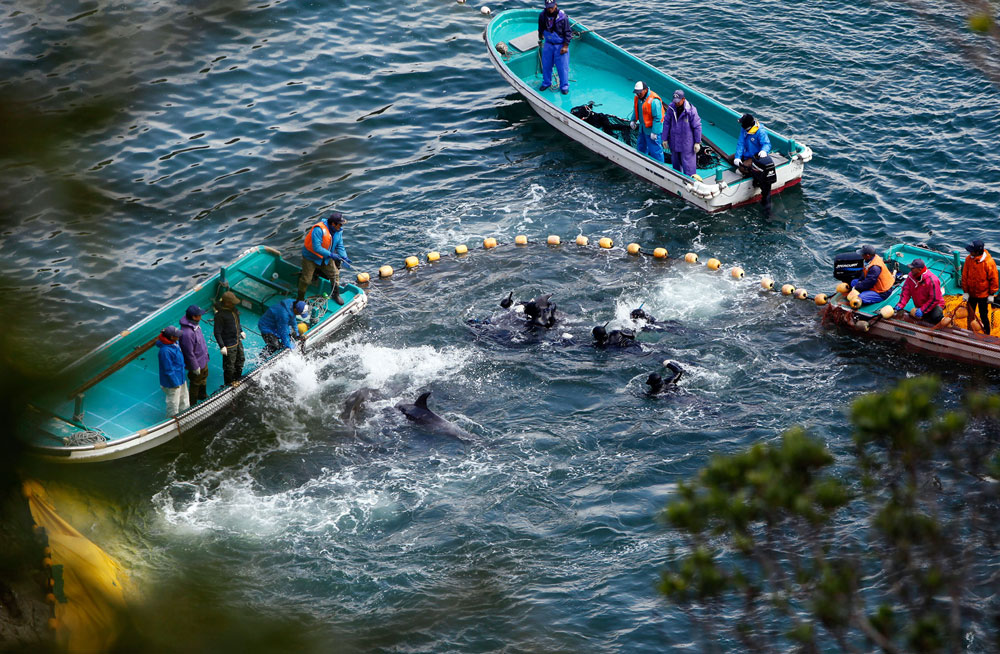
This year’s cull ended on March 1, and, according to statistics from the Dolphin Project, saw the slaughter of 293 striped dolphins, 235 Risso’s dolphins and 41 pilot whales. A total of 235 cetaceans were captured for sale to marine parks, including 20 Pacific white-sided dolphins, 179 bottlenose dolphins, 35 pantropical spotted dolphins and one pilot whale.
As earlier stated, Sea Shepard Conservation Society Founder Paul Watson estimates that a confounding 80 percent of China’s captive cetaceans come from Japan, with many – if not most – coming from Taiji.
American activist Richard O’Barry, who famously trained the dolphins used in the TV series Flipper and starred in 2009’s The Cove, has previously stated that many Chinese aquariums, including the Beijing Zoo Aquarium, host dolphins that came from that small, bloody cove in the land of the rising sun.
According to a 2015 article in The Guardian, between September 2009 and August 2014, 354 live dolphins were exported to 12 countries. Of the 354 cetaceans exported abroad, 216 were brought to China.
It is currently unclear how many of the cetaceans captured in the 2016-17 Taiji dolphin hunt are bound for China.
Popularity Wanes in the West, Rises in the East
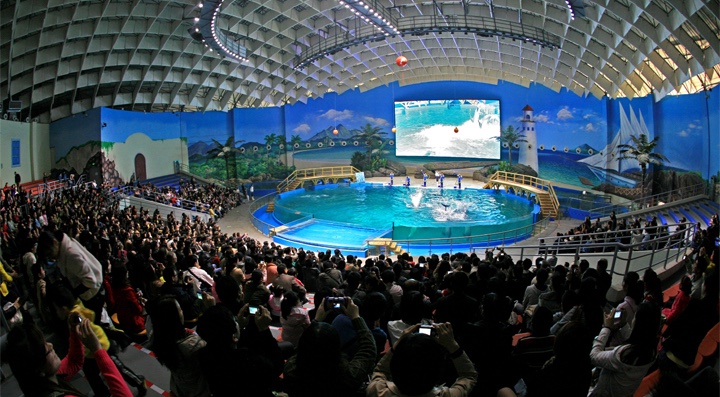
In March of last year, SeaWorld bowed to years of pressure from activists and announced it would be scrapping its orca breeding program and no longer make the animals perform tricks for live audiences.
Some attributed the move to the public backlash against the company in the wake of Blackfish, which has been credited with hurting attendance at the chain of marine theme parks, while SeaWorld framed the change as moving with changing social attitudes.
"Society's attitude toward these very, very large, majestic animals under human care has shifted for a variety of reasons, whether it's a film, legislation, people's comments on the Internet," said SeaWorld Entertainment CEO Joel Manby in a 2016 Bloomberg article.
It would seem, at long last, that orca – and cetacean captivity as a whole – is on the verge of defeat in America.
“Many countries copy the United States, particularly when it comes to making money,” said Watson. “We have the captivity industry on the ropes here and SeaWorld has lost money every year since Blackfish came out.
“Amusement parks make a lot of money, I don’t know what tickets cost in China, but they make millions of dollars.”
But with falling revenues at SeaWorld and orca shows being phased out, many trainers are now looking for work in new markets, the most booming and obvious of which is, you guessed it, China.
Almost all of the experts we spoke with in assembling this story agreed that former SeaWorld employees, as well as staff from SeaWorld-affiliated Loro Parque in the Canary Islands, are popping up at theme parks in China.
The great fear now is, with orcas making their China debut, more and more marine mammal parks will be looking for a blackfish of their own – fueling the demand for more captured whales from Russia’s Okhotsk Sea.
With the legacy of live orca captures firmly in the rearview mirror in America, China’s demand for cetaceans may mean the next ‘Penn Cove incident’ happens on this side of the Pacific.
[Images via allevents.in, National Geographic, Outside Magazine, Captive Cetaceans Tragically Sad, Haichang Polar Ocean Park]
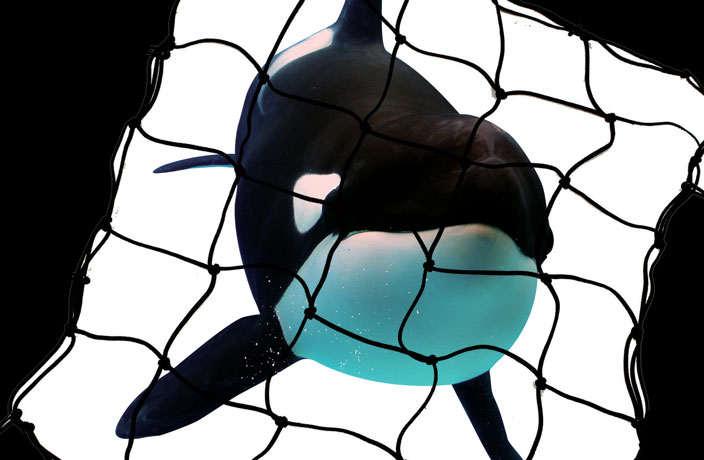





















0 User Comments